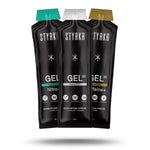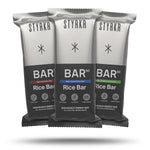Don't miss a moment and join the adventure, follow along the 2025 Silk Road Mountain Race.

The Silk Road Mountain race (SRMR) is an unsupported ultra-endurance cycling event through the mountains of Kyrgyzstan, covering 1,900 km and up to 30,000 metres of climbing.
In 2024, 172 riders set off bikepacking from Bishkek, embarking on one of the most physically and mentally demanding endurance challenges on two wheels. It’s intense, remote, and the ultimate test of endurance and mental adversity.
STYRKR is proud to be an official partner of this year’s event. We’re excited to see how the riders get on, and like others, will be tracking the progress of those in the mountains.
Follow the riders of The Silk Road 2025
Follow the live link below for this year’s Silk Road Mountain Race.
Track each rider's progress through the Kyrgyzstan mountains, desert, and unforgiving terrain in between.
Why the Silk Road Mountain Race?
 The Silk Road Mountain Race has earned a reputation as one of the toughest (and most captivating) events in ultra-endurance cycling.
The Silk Road Mountain Race has earned a reputation as one of the toughest (and most captivating) events in ultra-endurance cycling.
Riders traverse rugged gravel roads, high-altitude passes, and ride and camp in unpredictable mountain weather, often above 3,000 metres, where the altitude is high and the oxygen is low.
The route, although long and arduous, is highly rewarding. It’s equal parts suffering, beauty, and self-discovery. It’s an event like no other.
What makes it so difficult?
 The Silk Road mountain race is often described as one of the toughest bikepacking races worldwide.
The Silk Road mountain race is often described as one of the toughest bikepacking races worldwide.
Riders can expect approximately 1,900 km and more than 30,000 metres of climbing, with only 14 days to complete the route.
Like many rural bikepacking events, the Silk Road mountain race is self-supported. No outside support is allowed.
Riders follow the same route, but are responsible for getting from the start to the finish on their own.

Similarly to Bright Midnight, the clock never stops. Riders must choose how to manage rest versus speed. And that’s without mentioning nutrition: the fuel you need to give you much-needed energy to complete the event.
“Along with fatigue, you are hallucinating due to the lack of sleep. It’s a real mental toll to know you have such a long way to go and you’re however many nights away from a proper rest or 8 hours sleep,” explains Will Robinson, STYRKR and ultra endurance athlete.
Sleep deprivation increases muscular fatigue, negatively impacts decision-making, and makes consistent fuelling even more crucial.
The Silk Road takes riders through deserts, mountains, river crossings, and remote regions so desolate you will feel like you’re the last surviving person in the world. Temperatures range from 36 degrees Celsius to -10 degrees Celsius.
Races like the Silk Road Mountain Race, Tour Divide, Bright Midnight, and Transcontinental are not just physical challenges. They’re logistical puzzles that test mental strength just as much as physical.
Fuelling challenges in ultra bikepacking

“Racing a race such as this one puts totally new demands on your body, including altitude, 40 degree heat, sleep deprivation and an increased chance of chugging your guts up!
Every day challenges you differently from the last so having a routine and consistency when it comes to fuelling brings me some confidence and allows me to keep making sensible decisions," says Robinson.
Here's more fuelling challenges in ultra bikepacking:
- You can't "out-ride" bad fuelling: poor fuelling affects paces, focus, recovery, and energy. Eat early and often.
- Access to food is unpredictable: there are no aid stations. Riders must stock up on food from shops, bakeries, and gas stations (but these are also scarce)
-
Train your gut: practise eating 60-90g of carbs/hour during training to avoid digestive issues on longer rides. Don't leave it until race day (or week)!
- Make fuelling easy: pack energy bars, gels, and other convenient sports products for when you need them most.
-
Eat real food: consume real food like bananas, rice cakes, dehydrated meals, dried fruit, and sweet potatoes.
How to fuel for the Silk Road Mountain Race
 With up to 14 days of riding ahead, what you eat and how you fuel are crucial to your success.
With up to 14 days of riding ahead, what you eat and how you fuel are crucial to your success.
Here’s the STYRKR guide on how to fuel for the Silk Road Mountain Race.
Pre-race fuelling preparation
Your fuelling preparation for the Silk Road, or any other ultra-endurance bikepacking race, starts weeks before.
Use your training sessions, especially long rides, to get your nutrition correct. Also, practise proper hydration, which includes electrolytes (300-800mg/hr) for long and hot rides.
Test race week nutrition on long rides to see what works best for you.
If possible, simulate 8 + hour efforts with a full fuelling plan and see how you deal with cumulative fatigue.
Daily fuelling plan
The team at STYRKR has put together a sample daily fuelling plan for the Silk Road.
Please note, however, that this is very dependent on the resources available. There are often times you won’t find exactly what you need when you are in the middle of nowhere, so plan ahead and be prepared for a few options.
| Category | Details |
|---|---|
| A. Hourly Intake Strategy |
Carbs: 60–90 g/hr from mixed sources (drink mix, bars (e.g., BAR50), and real food) Electrolytes: 400–800 mg/hr, adjusted for sweat rate and climate Fluids: 500–750 ml/hr (more in heat) Snacks: Keep top-tube bag stocked with chews, mini Snickers, nuts |
| B. Morning Routine | High-carb + moderate protein breakfast (oats, bananas, coffee, nut butter) Pre-fill bottles with drink mix (e.g., STYRKR MIX90) |
| C. Midday Resupply | Stop every 4–6 hours in towns to grab: - Chocolate, nuts, bread, cheese, dried fruit - Water top-up or Coke for caffeine boost |
| D. Evening Recovery | Instant meal or bakery stop with 2:1 carbs to protein Use electrolyte tabs in water for overnight hydration |
Fuel storage and strategy
Another challenge of ultra-endurance bikepacking is carrying food, water, and other items. You can only carry so much when cycling long distances, and you likely won't have access to certain food items, like snacks, gels, and chews, except for what you pack.
And you'll need those sports products for quick bursts of energy. Carlotta Schumacher, ultra-endurance cyclist, explains how when a challenging section approaches, she uses a caffeine energy gel, like GEL30 Caffeine, saving these for race-defining moments.
Here's what to pack (and where).
| Location | Contents / Strategy |
|---|---|
| Top Tube Bag | Snacks, gels (e.g., GEL50), chews |
| Frame Bag | Bulk food (bars, spare wraps) |
| Bottle 1 | Water |
| Bottle 2 | Electrolyte and carb mix |
| Emergency Stash | 2–3 gels for mechanical delays or remote terrain |
Adapting for terrain & conditions
You may need to adjust your nutrition for the terrain and conditions. For example, when riding through stretches of desert, you will need water, salt, and electrolytes.
Ultra-endurance cyclist, Paddy Chapman, advises riders to stay on top of their salt loss, especially when temperatures climb to 36 °C. He recommends using a maximum-strength electrolyte such as STYRKR SLT+, which, he says, “will allow you to maintain cognitive function when the heat turns up.”
See the table below for recommendations on how to adapt your nutrition and fuelling strategy to suit the conditions.
| Condition | Adaptation |
|---|
| High altitude | Frequent small sips and snacks (appetite drops) |
| Hot weather | Prioritise liquid calories and salt; pre-hydrate |
| Cold weather | Keep food accessible; increase fat slightly |
| Night riding | Use caffeine strategically; light, digestible snacks |
Listen to the official race radio
Tune in to the official Silk Road Mountain Race radio, hosted by Mel Webb, adventure cyclist, to keep tabs on this year's event.
Start by listening to the race preview below and find out what participants can expect.

